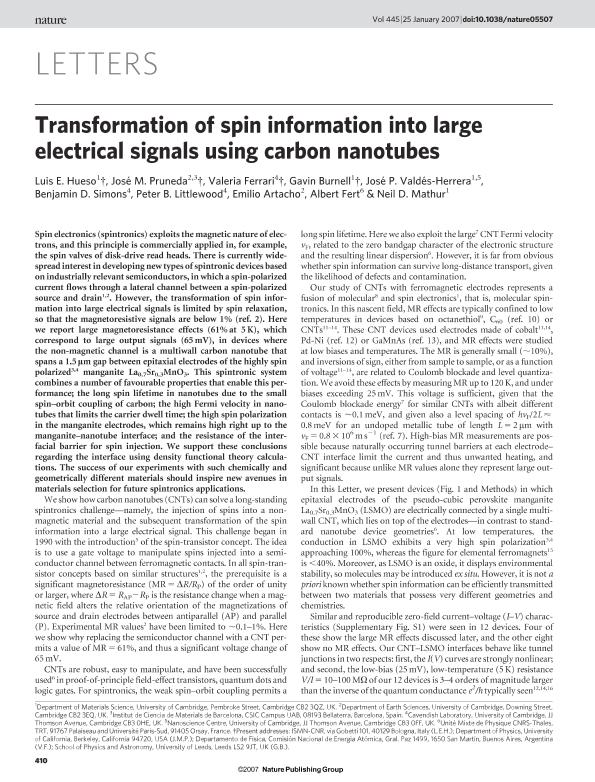Artículo
Transformation of spin information into large electrical signals using carbon nanotubes
Hueso, Luis E.; Alonso Pruneda, José Miguel; Ferrari, Valeria Paola ; Burnell, Gavin; Valdés Herrera, José P.; Simons, Benjamin D.; Littlewood, Peter B.; Artacho, Emilio; Fert, Albert; Mathur, Neil D.
; Burnell, Gavin; Valdés Herrera, José P.; Simons, Benjamin D.; Littlewood, Peter B.; Artacho, Emilio; Fert, Albert; Mathur, Neil D.
 ; Burnell, Gavin; Valdés Herrera, José P.; Simons, Benjamin D.; Littlewood, Peter B.; Artacho, Emilio; Fert, Albert; Mathur, Neil D.
; Burnell, Gavin; Valdés Herrera, José P.; Simons, Benjamin D.; Littlewood, Peter B.; Artacho, Emilio; Fert, Albert; Mathur, Neil D.
Fecha de publicación:
01/2007
Editorial:
Nature Publishing Group
Revista:
Nature
ISSN:
0028-0836
Idioma:
Inglés
Tipo de recurso:
Artículo publicado
Clasificación temática:
Resumen
Spin electronics (spintronics) exploits the magnetic nature of electrons, and this principle is commercially applied in, for example, the spin valves of disk-drive read heads. There is currently widespread interest in developing new types of spintronic devices based on industrially relevant semiconductors, in which a spin-polarized current flows through a lateral channel between a spin-polarized source and drain. However, the transformation of spin information into large electrical signals is limited by spin relaxation, so that the magnetoresistive signals are below 1% (ref. 2). Here we report large magnetoresistance effects (61% at 5 K), which correspond to large output signals (65 mV), in devices where the non-magnetic channel is a multiwall carbon nanotube that spans a 1.5 μm gap between epitaxial electrodes of the highly spin polarized manganite La0.7Sr0.3MnO3. This spintronic system combines a number of favourable properties that enable this performance; the long spin lifetime in nanotubes due to the small spin-orbit coupling of carbon; the high Fermi velocity in nanotubes that limits the carrier dwell time; the high spin polarization in the manganite electrodes, which remains high right up to the manganite-nanotube interface; and the resistance of the interfacial barrier for spin injection. We support these conclusions regarding the interface using density functional theory calculations. The success of our experiments with such chemically and geometrically different materials should inspire new avenues in materials selection for future spintronics applications.
Palabras clave:
SPINTRONICS
,
AB INITIO
,
NANOTUBES
,
MANGANITES
Archivos asociados
Licencia
Identificadores
Colecciones
Articulos(SEDE CENTRAL)
Articulos de SEDE CENTRAL
Articulos de SEDE CENTRAL
Citación
Hueso, Luis E.; Alonso Pruneda, José Miguel; Ferrari, Valeria Paola; Burnell, Gavin; Valdés Herrera, José P.; et al.; Transformation of spin information into large electrical signals using carbon nanotubes; Nature Publishing Group; Nature; 445; 7126; 1-2007; 410-413
Compartir
Altmétricas



